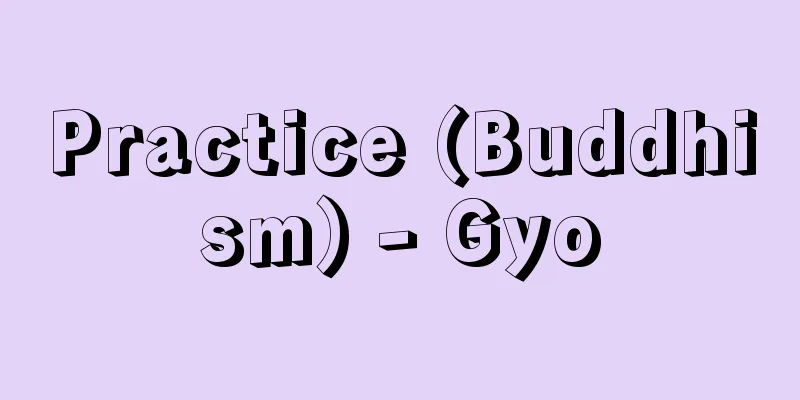Practice (Buddhism) - Gyo

|
…In Sanskrit, it is called pañca-skandha. It refers to the five elements that make up the living entity, or sentient being: form, feeling, thought, action, and consciousness. Of these, form (rūpa) includes the five sense organs that make up the body (the five roots), the five objects of those sense organs (the five realms), and the latent residual energy of action (unmanifest form). … From [Buddhism]...Currently, the religion has approximately 500 million followers, mainly in (1) Southeast Asian countries such as Sri Lanka and Thailand, (2) East Asian countries such as China, Korea, and Japan, and (3) Inner Asian regions such as Tibet and Mongolia, and is also gaining followers and ideological sympathizers in the United States and Europe. (1) Southern Buddhism (Southern Buddhism) was introduced in the 3rd century BC and spread mainly in Sri Lanka. It is Theravada Buddhism that uses the Pali scriptures. (2) Northern Buddhism was introduced from northwestern India through the Western Regions (Central Asia) and is Mahayana Buddhism based on Chinese translations of the scriptures. (3) Mahayana Buddhism was introduced later through Nepal and other places and uses Tibetan translations of the scriptures. The Buddhism of these regions has different histories and traditions, and the doctrines and forms of religious organizations are also diverse. However, they all share the goal of worshiping the founder Shakyamuni as the Buddha, listening to his teachings, and attaining enlightenment and liberation through practical training such as meditation. In India, where it originated, the religious organizations were destroyed in the 13th century and disappeared except in surrounding areas such as Nepal, but in modern times it has been revived by a religious and social movement called Neo-Buddhism. *Some of the terminology explanations that refer to "Gyo (Buddhism)" are listed below. Source | Heibonsha World Encyclopedia 2nd Edition | Information |
|
…サンスクリットでは,パンチャ・スカンダpañca‐skandhaという。生命的存在である〈有情(うじよう)〉を構成する五つの要素すなわち,色(しき),受(じゆ),想(そう),行(ぎよう),識(しき)の五つをいう。このうち色(ルーパrūpa)には,肉体を構成する五つの感覚器官(五根)と,それら感覚器官の五つの対象(五境)と,および行為の潜在的な残気(無表色(むひようしき))とが含まれる。… 【仏教】より…現在,(1)スリランカ,タイなどの東南アジア諸国,(2)中国,朝鮮,日本などの東アジア諸国,(3)チベット,モンゴルなどの内陸アジア諸地域,などを中心に約5億人の教徒を有するほか,アメリカやヨーロッパにも教徒や思想的共鳴者を得つつある。(1)は前3世紀に伝道されたスリランカを中心に広まった南伝仏教(南方仏教)で,パーリ語仏典を用いる上座部仏教,(2)はインド北西部から西域(中央アジア)を経て広まった北伝仏教で,漢訳仏典を基本とする大乗仏教,(3)は後期にネパールなどを経て伝わった大乗仏教で,チベット語訳の仏典を用いるなど,これらの諸地域の仏教は,歴史と伝統を異にし,教義や教団の形態もさまざまであるが,いずれもみな,教祖釈迦をブッダ(仏)として崇拝し,その教え(法)を聞き,禅定(ぜんじよう)などの実践修行によって悟りを得,解脱(げだつ)することを目標とする点では一致している。なお,発祥の地インドでは13世紀に教団が破壊され,ネパールなどの周辺地域を除いて消滅したが,現代に入って新仏教徒と呼ばれる宗教社会運動が起こって復活した。… ※「行(仏教)」について言及している用語解説の一部を掲載しています。 出典|株式会社平凡社世界大百科事典 第2版について | 情報 |
<<: Gyoakana spelling - Gyoakana spelling
Recommend
Beneficial expenses - Yuuekihi (English spelling)
Expenses that contribute to increasing the value o...
Mosque - Mosque (English spelling)
A Muslim place of worship. The Arabic word masjid...
Year-end sweetfish - Etsunen ayu
...This state is called "rust" and they...
Glasscobo Culture - Glasscobo Culture
An early Bronze Age culture in Trans-Baikal, Russi...
United States Military Academy - United States Military Academy
…Located on the Hudson River in southeastern New ...
hatch; hatchway
(1) A ship's hatch or access point. A hole in ...
Shumway, NE (English spelling)
…In the 1940s, Peter Brian Medawar (1915-1987) an...
Uncertainty principle
When measuring the position and momentum of parti...
allogenic succession
…On the other hand, the influence of the environm...
Ghawar Oil Field
The world's largest oil field, located east o...
Sinotaia quadrata histrica (English spelling)
…The small pig snail Margarya melanoides from Yun...
Cancer Center
In response to the high incidence of cancer patien...
Czech Philharmonic Orchestra - Czech Philharmonic Orchestra (English name) Česká filharmonie
Czech Symphonic Orchestra. Its first concert was h...
Fairy - Fairy
They are supernatural beings who live in a world ...
Zelenka, Jan Dismas
Born: October 16, 1679, Raunowitz Died December 22...




![Ama [town] - Ama](/upload/images/67cad851109a3.webp)




